Best Day Hikes in Death Valley National Park, California
Article Topics: Best Hikes in Death Valley, Top Trails in Death Valley, Day Hiking in Death Valley National Park
Home to huge sand dunes, panoramic vistas, rugged mountains, vast salt flats, colorful badlands and mysterious canyons, Death Valley National Park is a hiker’s paradise.
In this post, I share my favorite Death Valley hikes, from easy strolls to strenuous loops.
7 Best Hiking Trails in Death Valley National Park
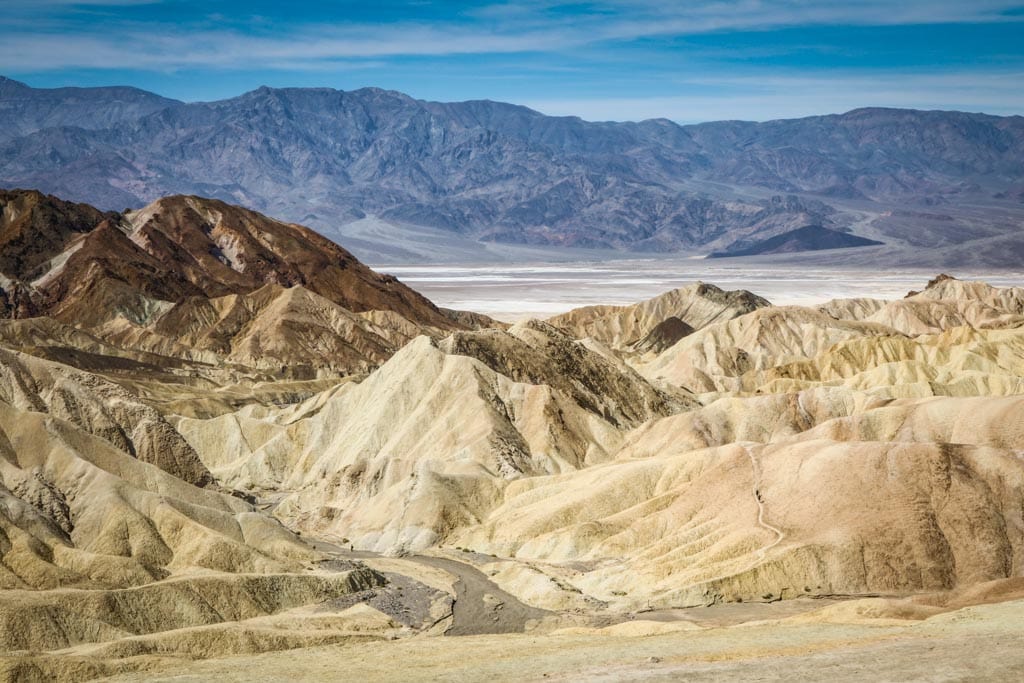
Death Valley features one of California’s most iconic stretches of asphalt, making it a super-popular destination among road trippers, bikers and cyclists. And I agree, driving across this enormous park is great fun—and simply necessary to get to its spread-out attractions.
But like I say about every park, hitting the trails is the best way to experience it. This also goes for Death Valley, where awesome trails loop through golden hills, run across salt flats, and wind through canyons.
This best Death Valley hikes post contains affiliate links. You can read more about our Terms of Use / Disclosure here.
Best Death Valley National Park Day Hikes
Note that there are many other great hiking trails in Death Valley, though—I just didn’t have enough time to do them all.
However, I do think that most people would agree that the following are definitely among the park’s greatest. They’re listed from easy to strenuous.
1. Salt Creek Interpretive Trail
Best for: seeing unique wildlife
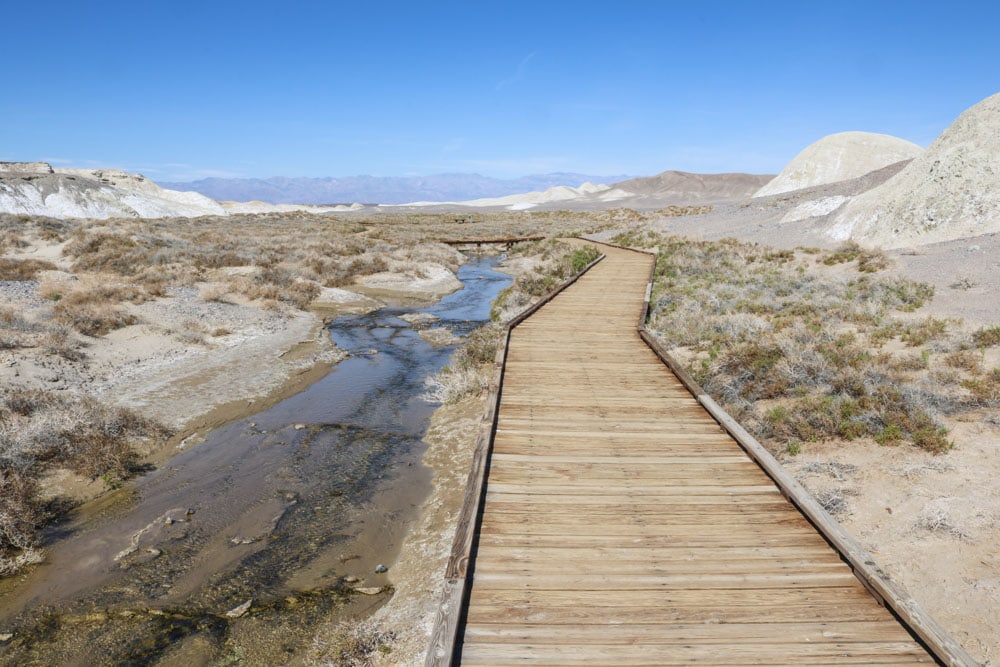
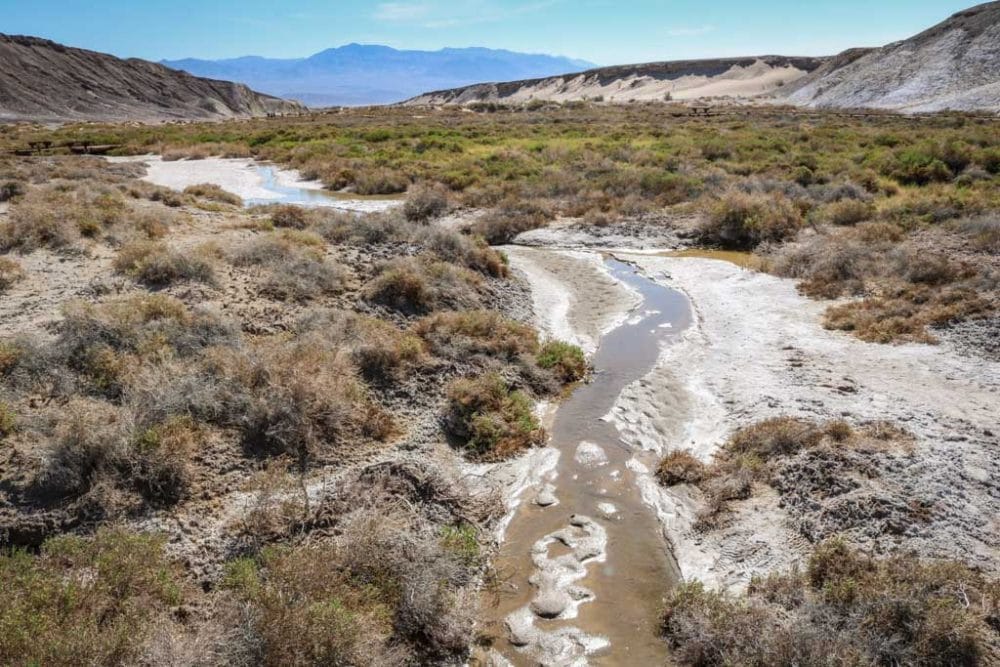
Salt Creek, on Highway 190 between Stovepipe Wells and Furnace Creek, is home to Cyprinodon salinus salinus, commonly known as Salt Creek pupfish. In fact, it’s the only home of these fish in the entire world.
In prehistoric times, Death Valley used to be a massive lake. After that lake dried up about 10,000 years ago, only small streams, springs and trickles were left. Salt Creek is one of those, the last habitat of the evolutionary descendants of fish that once lived in that large lake.
Pupfish are exceptional in the sense that they adapted from living in freshwater to surviving in saltwater.
That’s a truly remarkable feat in itself, but these rare pupfish are also able to survive in water that ranges in temperature from almost freezing to 108°F (42°C). They’re one of the hardiest fish species in the world.
A half-mile boardwalk loops around and over Salt Creek and its pools, wetlands, pickleweeds and salt grasses.
The best time of year to see pupfish frolicking in the water is spring, which is when they spawn are most active. (They go dormant in summer when the water stops flowing.)
- Roundtrip distance: 0.5 miles (loop, wheelchair accessible)
- Duration: 30 minutes
- Difficulty: Easy
- Trailhead: End of unpaved Salt Creek Road, 13 miles west of Furnace Creek
2. Dante’s View Trails
Best for: sunset strolls in the Black Mountains
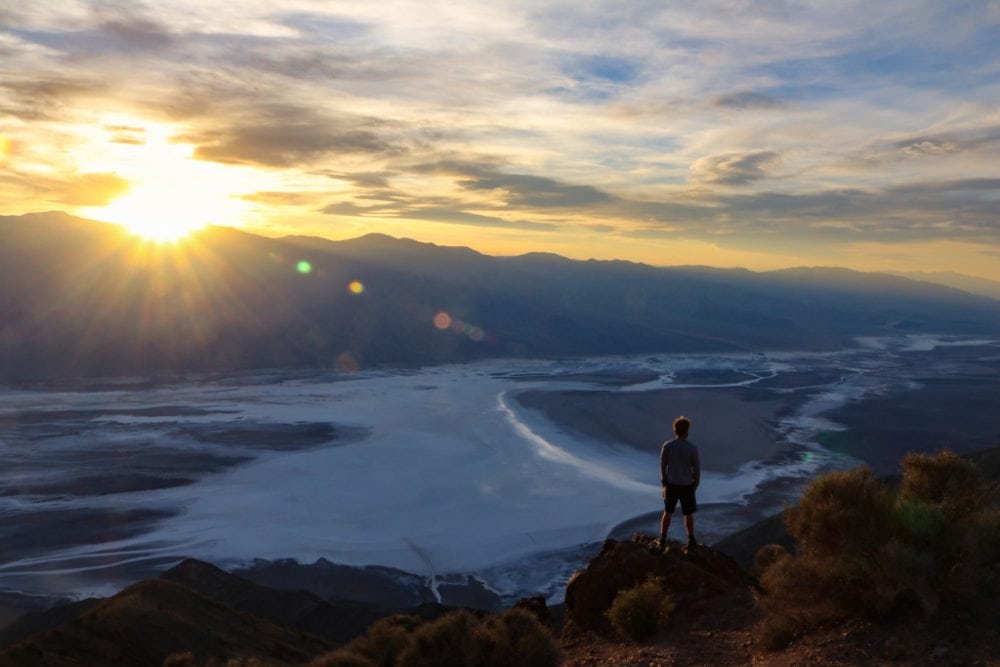
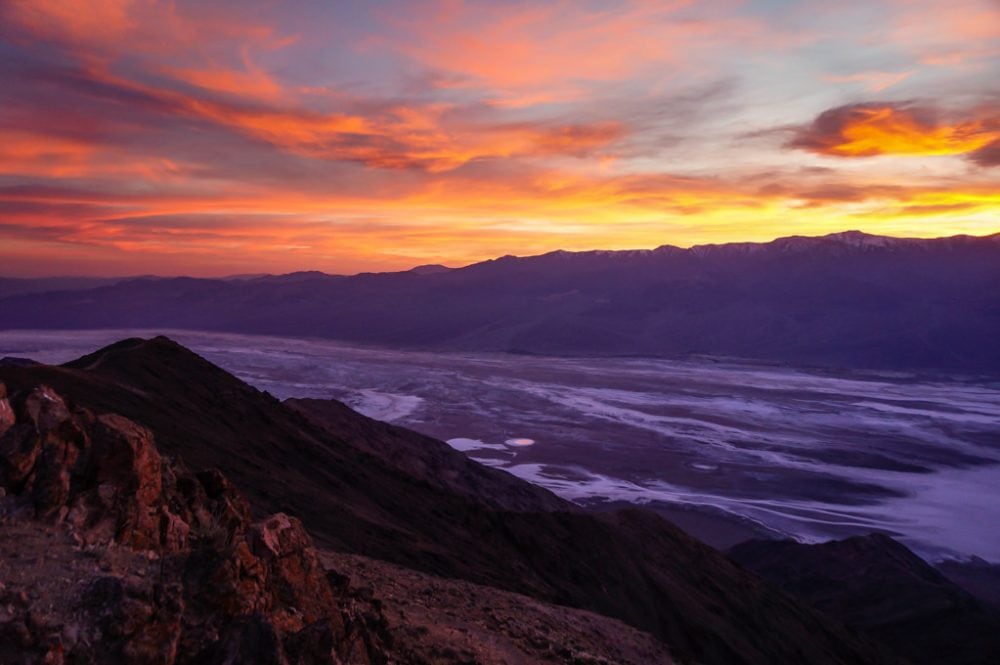
Serious hikers may not consider this to be an actual hike, but I still think Dante’s View, the top of the Black Mountains, is worth mentioning. It’s a fun little walk no matter how you want to classify it.
The highest Death Valley viewpoint accessible by road, Dante’s View is about 5,500 feet above Badwater Basin below. It’s one of the park’s greatest spots to watch the sunset.
From the parking lot viewpoint, two trails run along the ridge line in both directions. Neither is particularly long, but they do offer better views than the parking lot.
- Roundtrip distance: 1 mile (out and back)
- Duration: 30 minutes
- Difficulty: Easy
- Trailhead: Dante’s View Parking Area
3. Mesquite Flat Sand Dunes
Best for: an unrestricted adventure in desert sand dunes
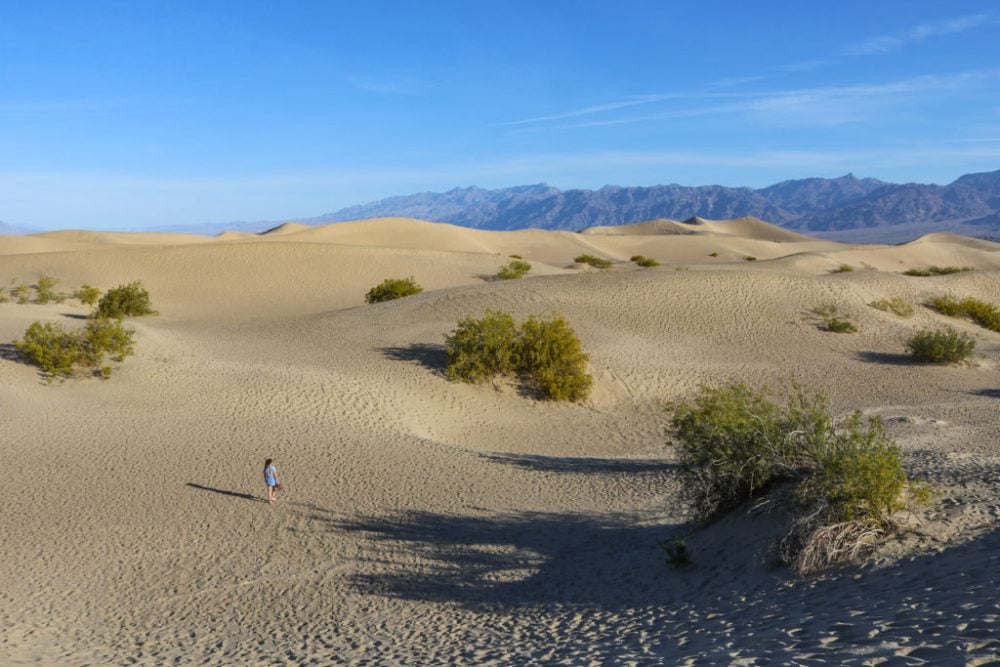
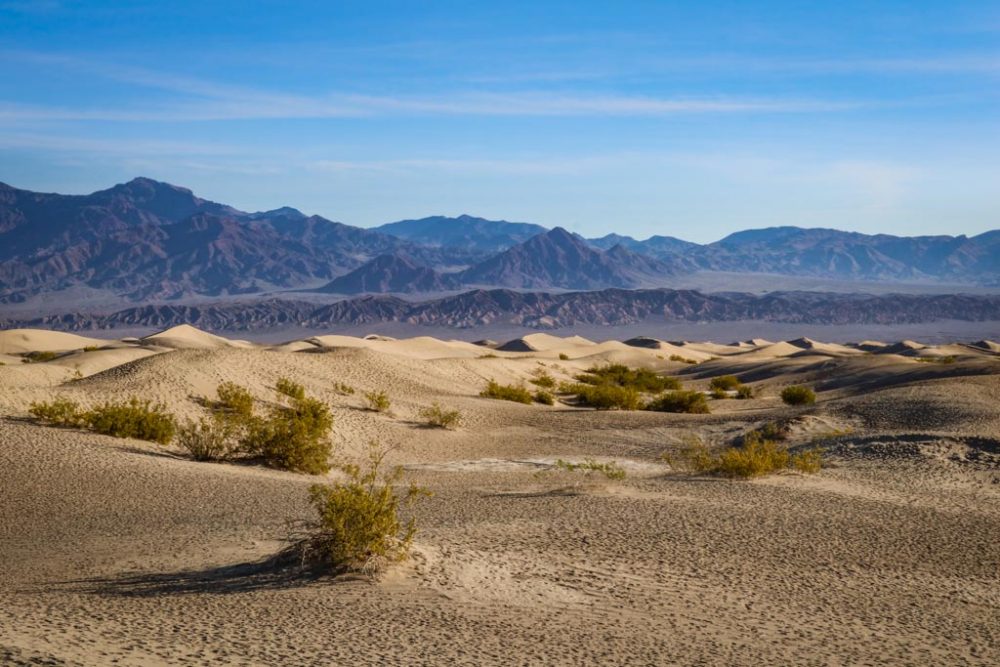
Consisting of three different dune types—star, crescent and linear dunes—the Mesquite Flat Sand Dunes are a super-fun outdoor playground. Children and adults alike will have a blast wandering through these hills of soft sand.
They are no official hiking trails here. You’re allowed to explore as you please. Climbing the dunes, jumping, running and rolling down,… it’s all allowed and it’s so much fun.
In terms of footwear, consider wearing closed hiking boots or simply going barefoot.
The largest dune field in Death Valley National Park, these rolling sandy hills at their most photogenic around sunrise and sunset. Under a full moon, they’re absolutely magical. If you want to go for a couple-hour dune hike, I recommend doing that early in the morning or just before sunset.
It gets hot in the desert during the day, up to a point that the sand’s temperature is so high that’s unbearable to walk on it. If you want to go barefoot, the only time of day that’s comfortable is in the morning.
I had a blast exploring these dunes. This is definitely one of the best Death Valley National Park hikes, especially if you’re looking for something different and downright fun.
- Roundtrip distance: 2+ miles (out and back)
- Duration: 1.5+ hours
- Difficulty: Easy
- Trailhead: Parking lot just east of Stovepipe Wells Village
4. Badwater Basin Crossing
Best for: a multi-hour trek below sea level
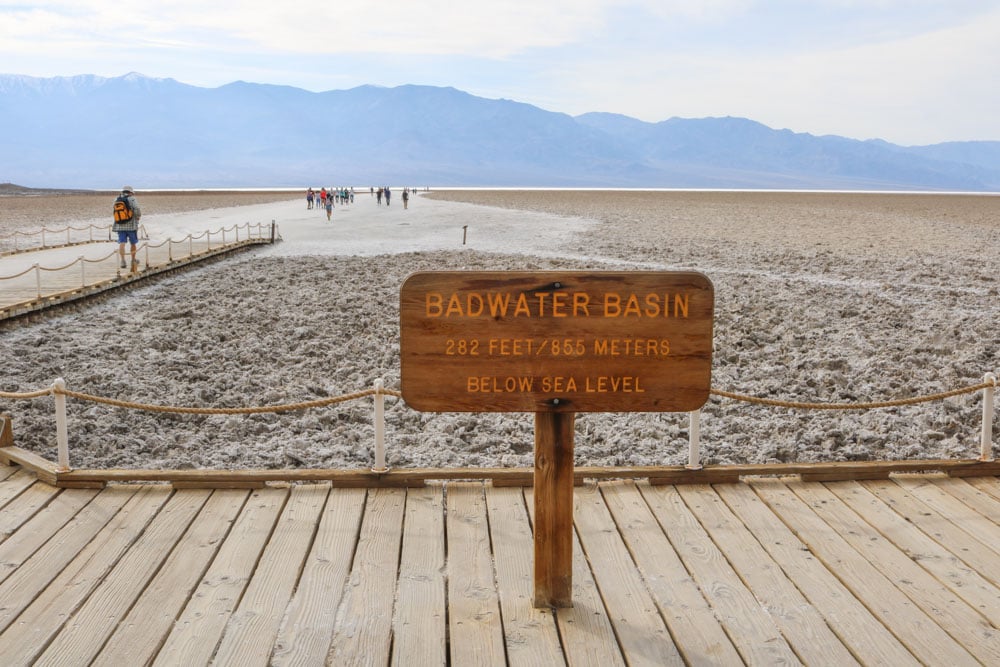

Badwater Basin is home to the lowest point in North America, one of the many things that make Death Valley National Park so extraordinary.
That lowest point lies 282 feet (86 meters) below sea level and is reached after a short walk across the salt pans from the parking lot. From Furnace Creek, you can get there in about 25 minutes.
This is arguably the most well-known of all places to visit in Death Valley, one of the most popular Death Valley National Park hiking locations.
When you walk the salt pan, absolutely make sure to wear a hat and put on some sunscreen. It gets scorching hot and the white salt reflects the sun rays, doubling your chances to get sunburned.
While most visitors only walk a short distance out into the salt flats, it’s entirely possible to cross the entire valley. Note, though, that although the first section is flat, the further out you get, the rougher the terrain becomes.
The Badwater Basin crossing is neither a completely flat nor a quick hike. It’s 6.5 miles to the other side and there’s not a patch of shade to be found anywhere.
This remote hike should only be done from late-fall through spring. Don’t do this Death Valley hike in summer!
- Roundtrip distance: 13 miles (out and back)
- Duration: 5 hours
- Difficulty: Easy to moderate
- Trailhead: Badwater Basin parking area
5. Desolation Canyon Trail
Best for: off-the-beaten-path exploration of a colorful canyon

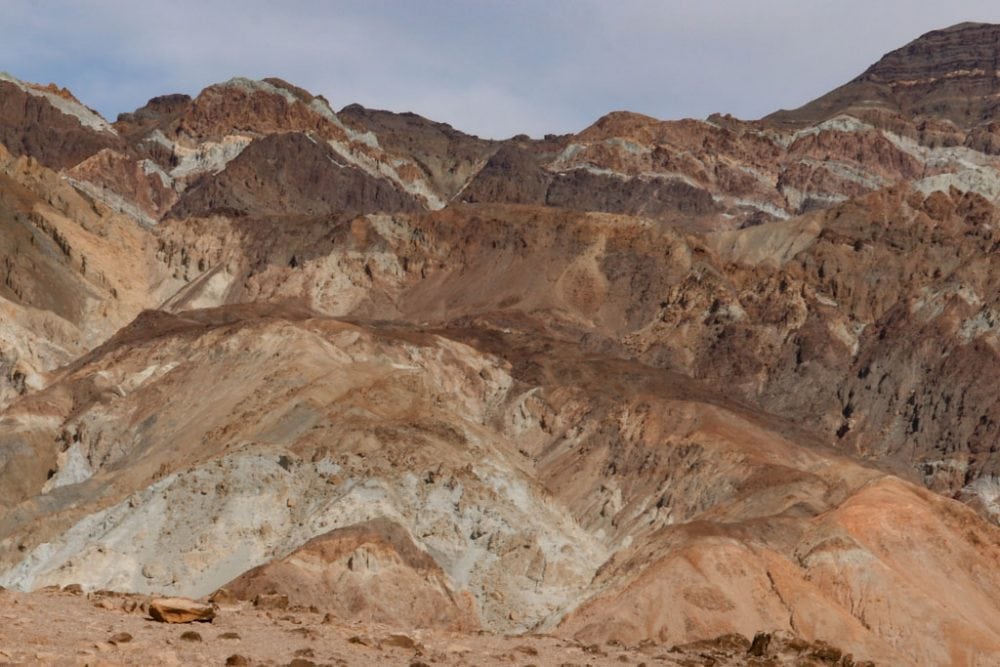
If you’re looking for a hike in Death Valley away from the crowds, the Desolation Canyon trail near famous Artist’s Palette is a fantastic option.
This is an unmarked trail, but finding your way is as easy as it gets—the trail is literally a desert wash through a canyon. It’s a great hike for an entry-level cross-country adventure in a designated wilderness.
The first section is through the wash, which leads you into the Black Mountains. As soon as you enter the canyon, the colorful walls will rise quickly around you.
Although this hike is an out-and-back adventure through the main canyon of Desolation Canyon, you’re free to explore the many small side canyons, too.
Getting lost is pretty hard here, but in case you do lose your bearings, remember that—because the canyon is carved by flowing water—downhill is generally the way back to where you came from.
- Roundtrip distance: 3.6 miles (out and back)
- Duration: 2 – 2.5 hours
- Difficulty: Moderate
- Trailhead: End of Desolation Canyon Road, off Badwater Road just south of CA-190
6. Badlands Loop Hike
Best for: Death Valley’s most iconic vistas
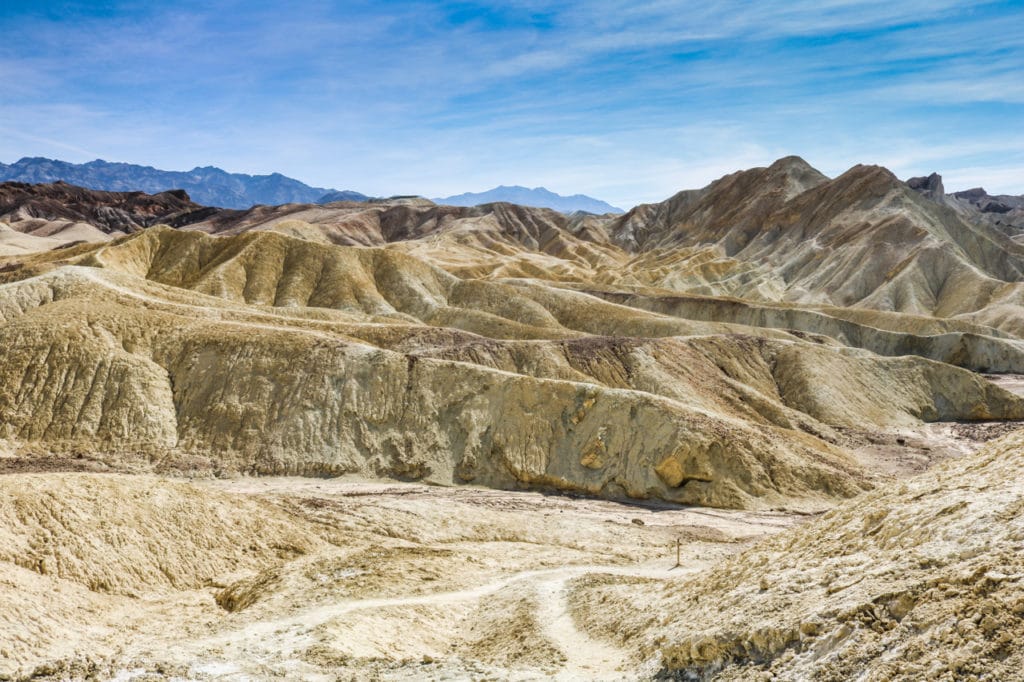
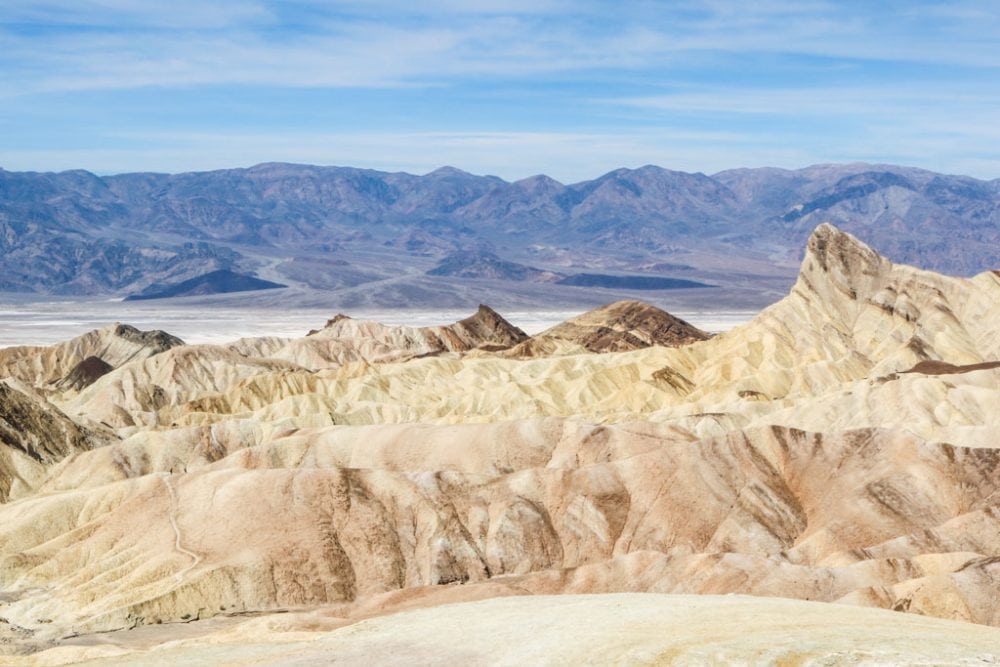
One of the most scenic and memorable hikes in Death Valley National Park is the Badlands Loop. This amazing circuit starts and ends at the park’s most popular viewpoint—Zabriskie Point.
The trail runs down into the maze of golden badlands below, which consist of an ancient lakebed. It’s a magnificent day hike, one that I recommend if you only have a day and want to do an immersive hike.
On the way, you get to enjoy some of Death Valley’s greatest views, as well as feel the power of this primeval landscape as you weave through a labyrinth of gullies and drainages.
For a more challenging hike in this area, see the Golden Canyon, Gower Gulch and Badlands Loop below.
- Roundtrip distance: 2.7 miles (loop)
- Duration: 1.5 – 2 hours
- Difficulty: Moderate
- Trailhead: Zabriskie Point
7. Golden Canyon, Gower Gulch and Badlands Loop
Best for: adventure in the maze-like canyons and badlands of Death Valley
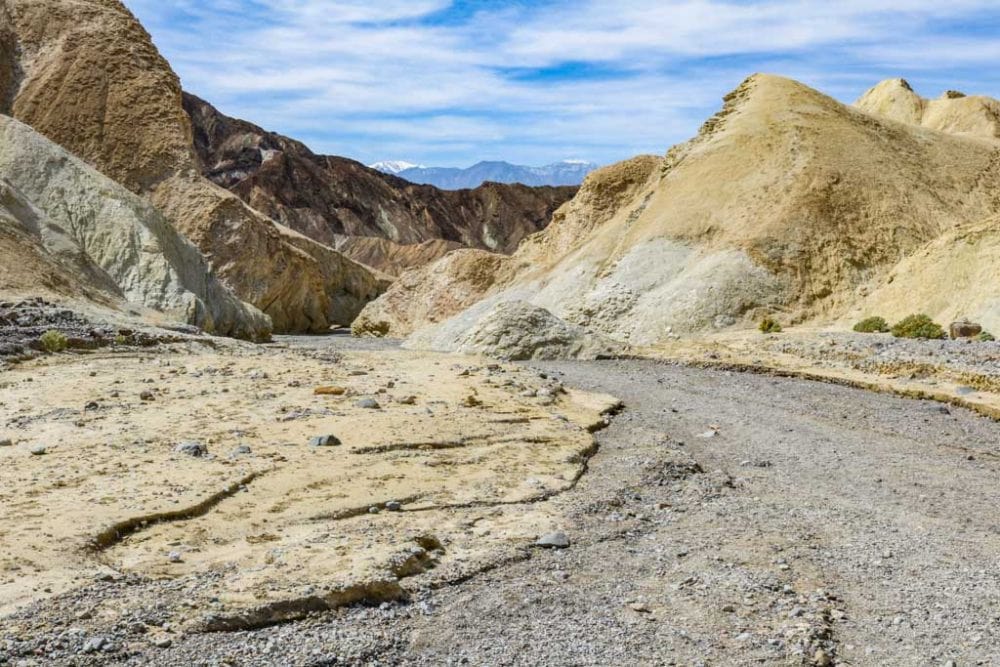
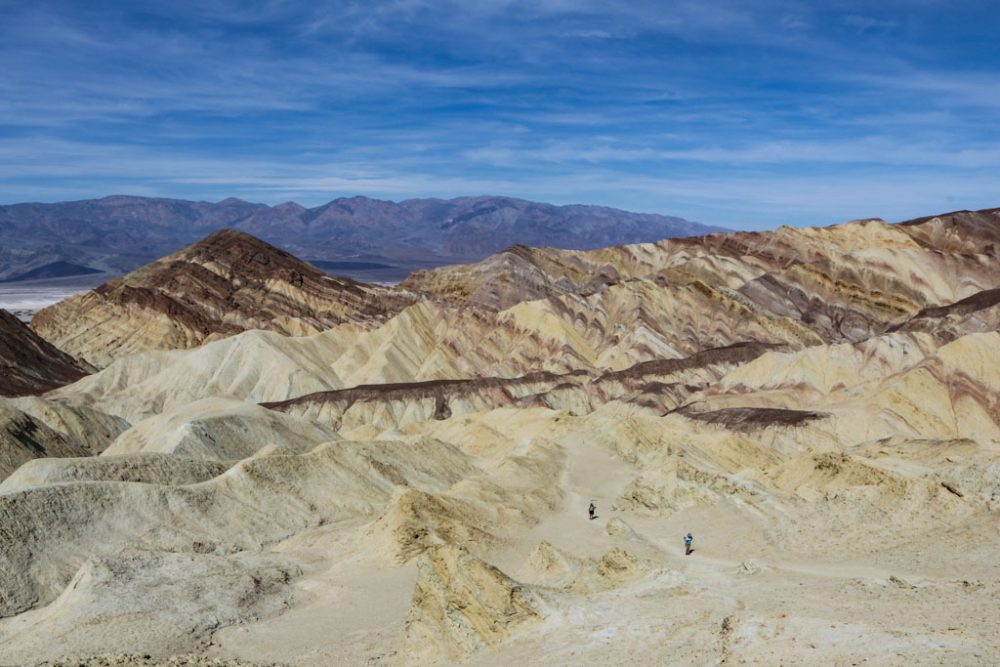
One of my favorite Death Valley activities, this three-trail loop hike takes you through the heart of Death Valley’s golden badlands. It leads through barren canyons and gullies, and to places like Red Cathedral and spectacular Zabriskie Point.
A significantly longer version of the Badlands Loop above (which it also includes), the entire circuit is about 8 miles (13 kilometers) long and takes at least four hours.
You can start the hike at either Zabriskie Point or at the parking lot off Badwater Road. I suggest starting at the Badwater Road parking lot. This way, you’ll save the (more or less) downhill part of the hike for the way back.
It’s a challenging hike in a sun-drenched, shadeless and hot desert landscape. Saving the most strenuous section—back up to Zabriskie Point—for last isn’t an option I would recommend.
This strenuous hike is one of the best day hikes I’ve ever done in a national park. In fact, if you do anything in the park, let it be this hike. In my opinion, it’s by far the best hike in Death Valley.
Start this hike as early in the morning as you can, bring lots and lots of water, put on a hat and wear sunscreen.
- Roundtrip distance: 8 miles (loop)
- Duration: 4 – 5 hours
- Difficulty: Strenuous
- Trailhead: Golden Canyon Trailhead on Badwater Road (or Zabriskie Point)
Hiking Death Valley FAQ
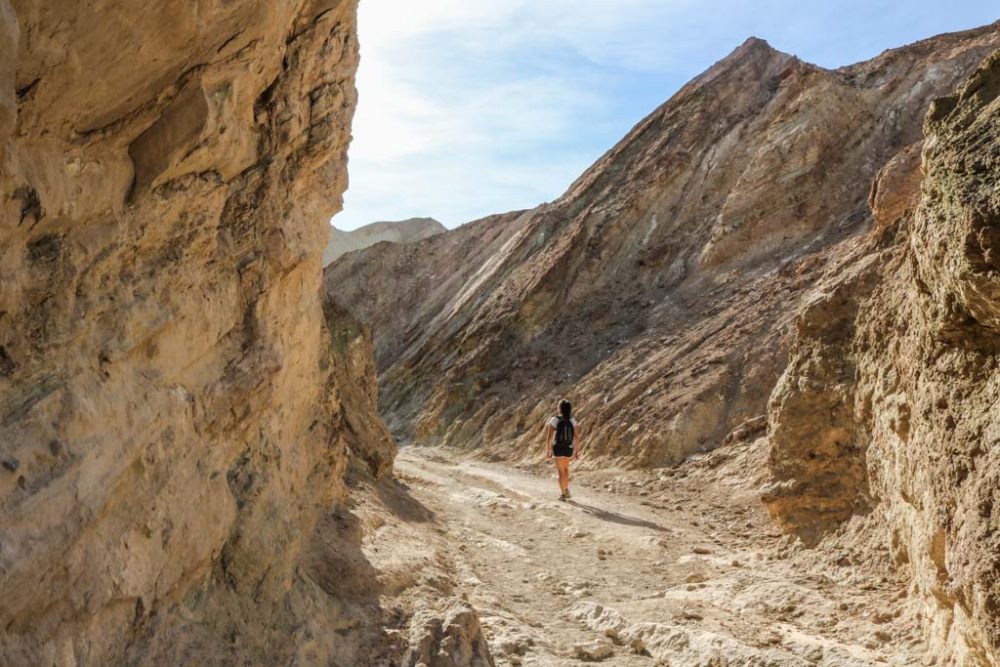
What Is the Best Time for Hiking in Death Valley National Park?
The Death Valley National Park website is pretty clear about the answer to this question.
“The best time to hike in Death Valley is from November through March. Summer temperatures can be dangerous in the park’s lower elevations. Even during spring and autumn the heat can be unbearable for most people. Save the low elevation hikes for the cooler winter days. The high peaks are a pleasant escape from the heat in summer, but are usually covered with snow in the winter and spring.”
Spring is by far the best time to go hiking in Death Valley. That’s not only because the weather is at its best from February through April, but spring is also the optimal time to see the Salt Creek pupfish and the park’s famous wildflowers.
Are There Any Dangerous Animals I Should Watch Out For?
Even though its name might indicate otherwise, Death Valley is actually full of life. Animals that are often spotted include lizards, roadrunners, ravens and ground squirrels. Perhaps surprisingly, Death Valley National Park is also one of the best parks for bird watching!
All those creatures are typically shy and elusive, but there are also several animals in Death Valley you should be careful of.
There are a number of potentially dangerous animals in the park, including coyotes, mountain lions, bees and wasps, black widow spiders, scorpions and rattlesnakes. Encounters with these animals are rare, though, but they do occasionally happen.
Don’t feed or leave food out for any wild animals. Always watch where you put your feet and hands.
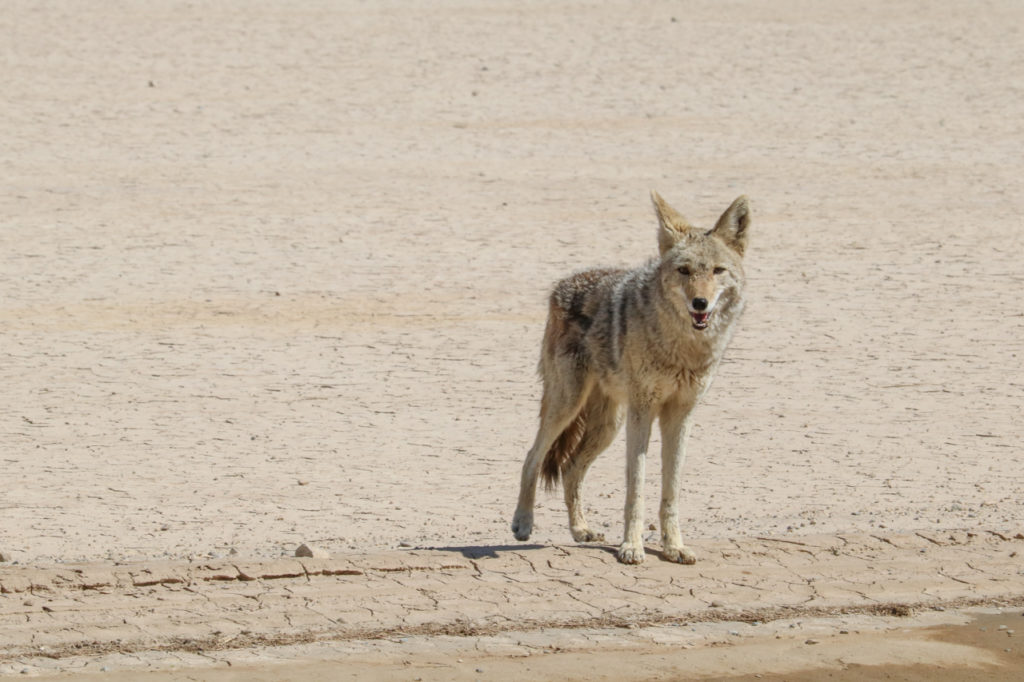
Can I Bring My Dog on a Hike?
While it may sound like a fun idea to visit Death Valley National Park with your dog, it’s absolutely not recommended. This is not one of America’s most dog-friendly national parks.
In Death Valley, pets must always be on a leash or confined. They’re only allowed along the roads and in developed areas. So, you cannot take your dog on any trails in the park!
You can, however, walk your dog (on a leash) on backcountry roads. The closest any of that comes to actual hiking in Death Valley is on Titus Canyon Road and the Twenty Mule Team Canyon Road.
So, in short, dogs are not allowed on trails in Death Valley, but you can walk them along all public roads, both paved and unpaved.
What Are the Best Death Valley Hikes If I Only Have One Day?
If you only have a day in Death Valley, there are three hikes I recommend.
- Morning: Badlands Loop just after sunrise (2.7-mile loop below Zabriskie Point)
- Day: Badwater Basin hike to the lowest point in North America (1-mile roundtrip to the salt flat)
- Evening: Mesquite Flat Sand Dunes 1-2 hours before sunset (2-mile roundtrip to the High Dune)
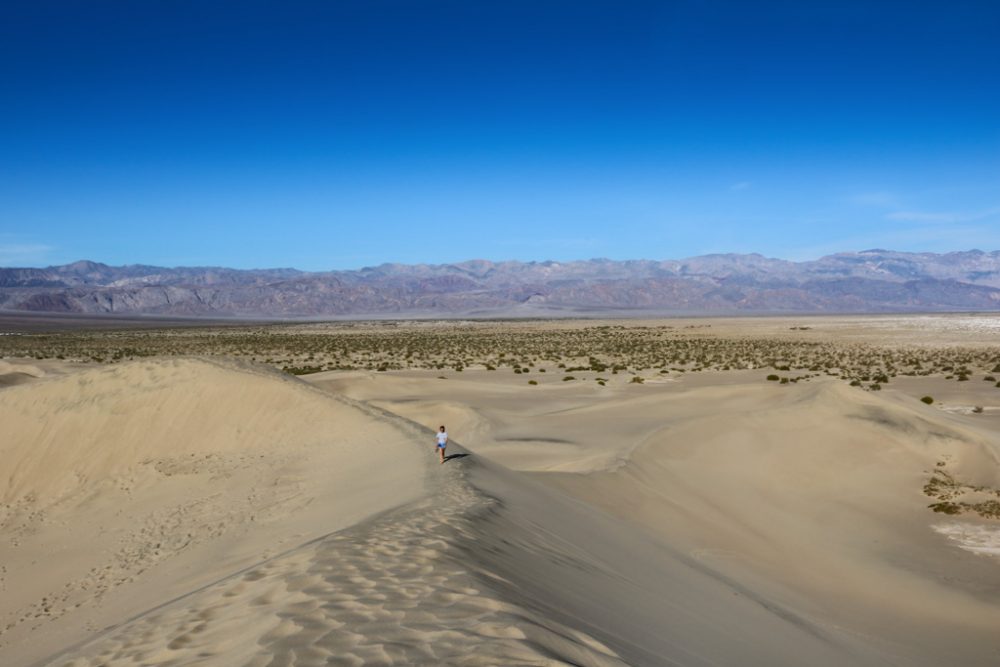
Are There Any Showers in Death Valley?
Yes, there are. However, most of them aren’t available for the general public because they’re at accommodations. So, unless you’re staying at a resort, lodge or motel, you won’t be able to just use their showers.
The only exception I know of—because I’ve used them myself—are the showers at the swimming pool in Stovepipe Wells Village. You can use both the pool and the showers for a small fee.
During my visit to Death Valley National Park, I camped across the street at the first-come first-served Stovepipe Wells Campground. Every evening, after a long day of hiking and exploring, I would pay the fee, shower, jump in the pool and shower again.
It was absolutely delightful!
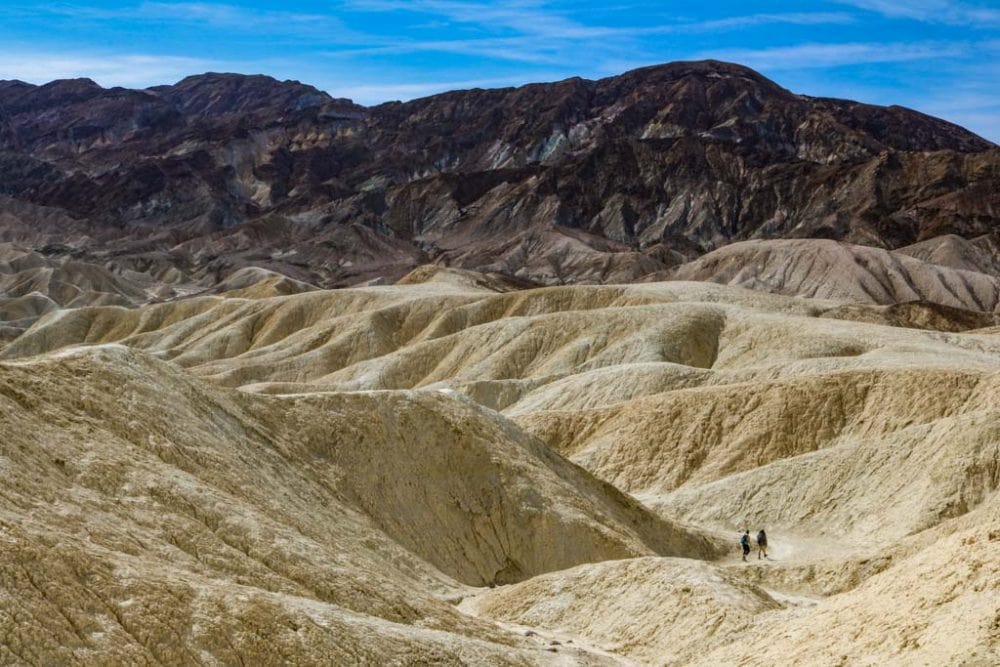
Death Valley National Park Hiking Guidelines & Safety Tips
Death Valley is a popular destination all year round, but especially in spring. To protect the park’s fragile resources, there are a number of rules in place.
Additionally, since this is a desert environment—the hottest and driest place in North America—you need to take proper precautions when you’re going for a hike, even if it’s a short one.
- Leave everything as you find it
- Don’t take any rocks or salt; take all waste and trash back with you
- Except in Badwater Basin and the Mesquite Flat Sand Dunes, you should always stay on the trail
- Be a courteous hiker, be kind to others, help other people if you see they’re in trouble
- Wear sturdy hiking shoes or boots
- Put on sunscreen and wear a hat
- Always bring lots of water (at least 2 liters per person for a short hike, more for longer ones)
- Bring plenty of (salty) snacks
- Summer hiking in Death Valley is not recommended. Temperatures regularly exceed 100°F (38°C)
Death Valley National Park Trails Map
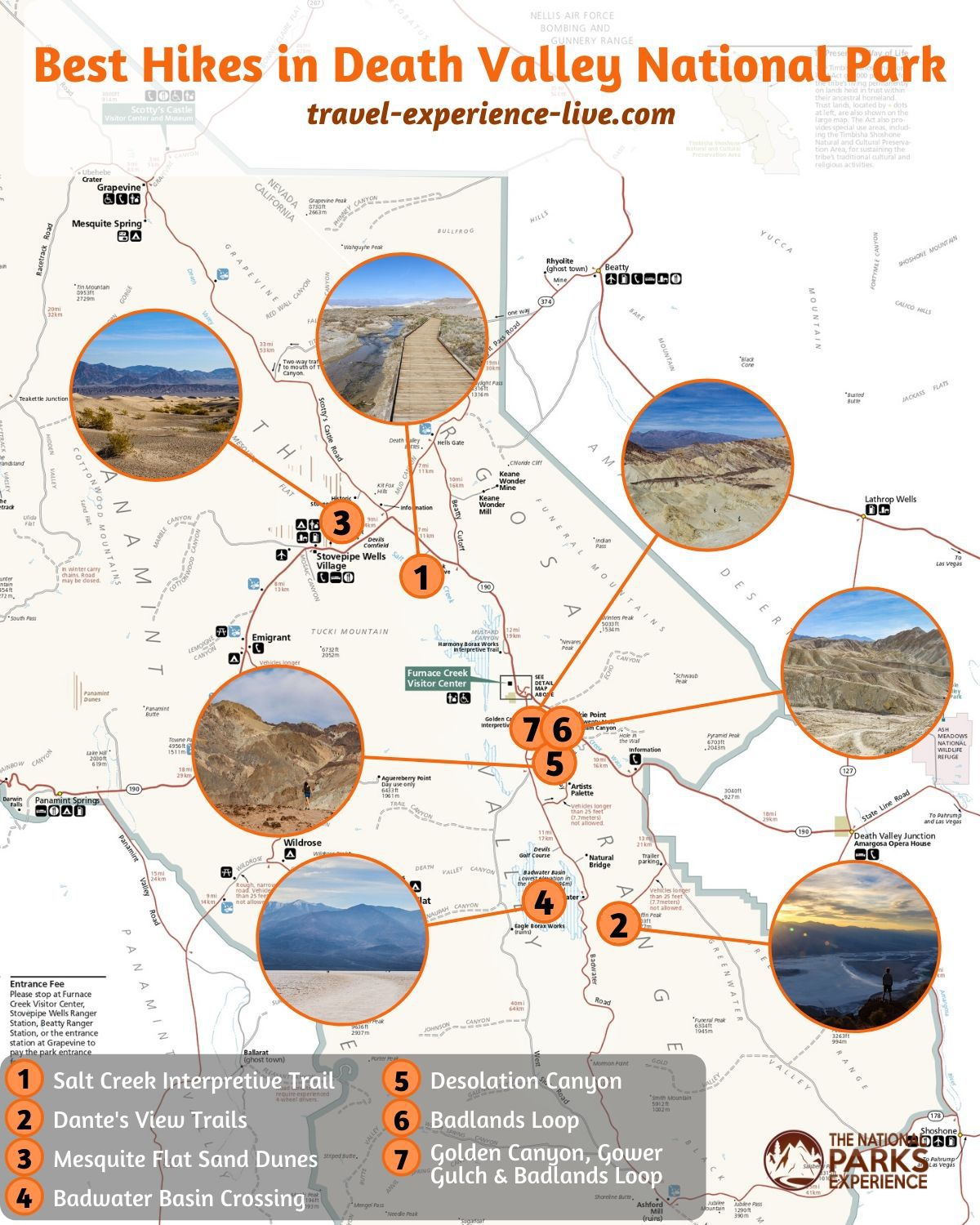

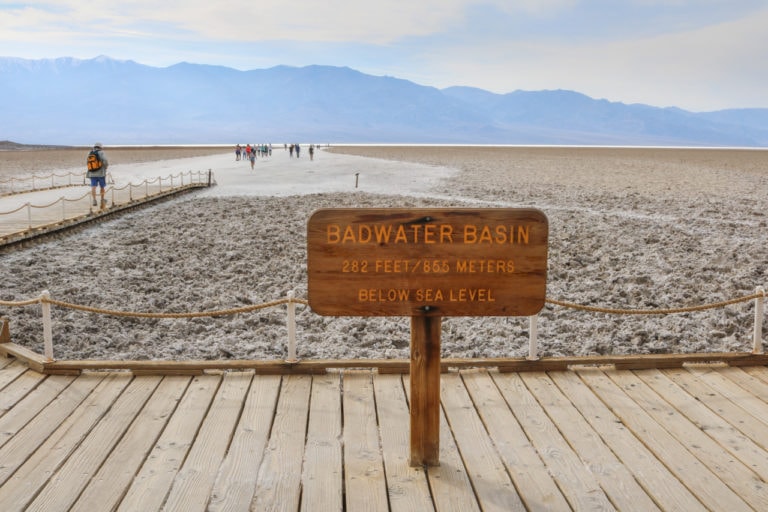
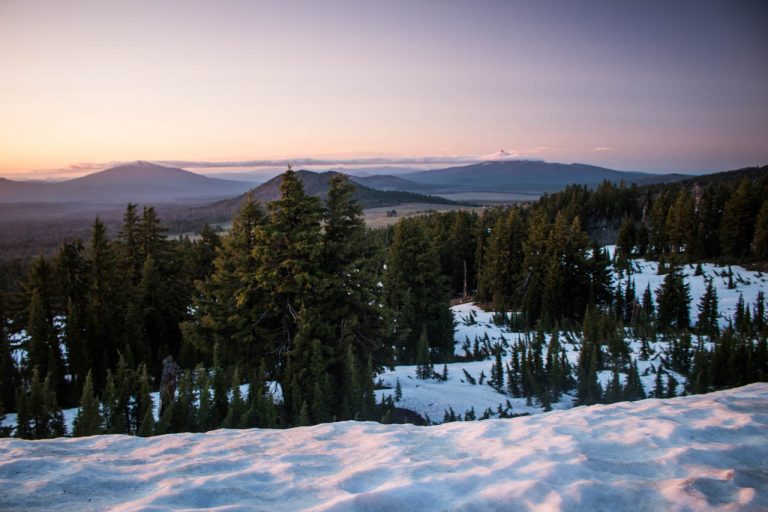

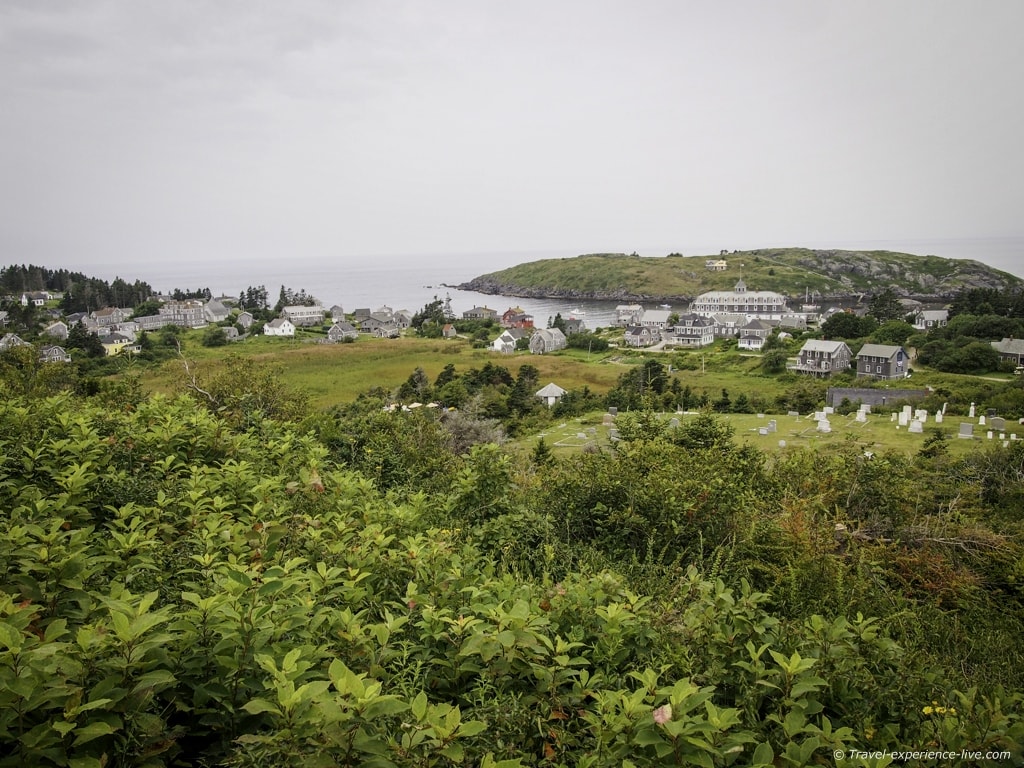

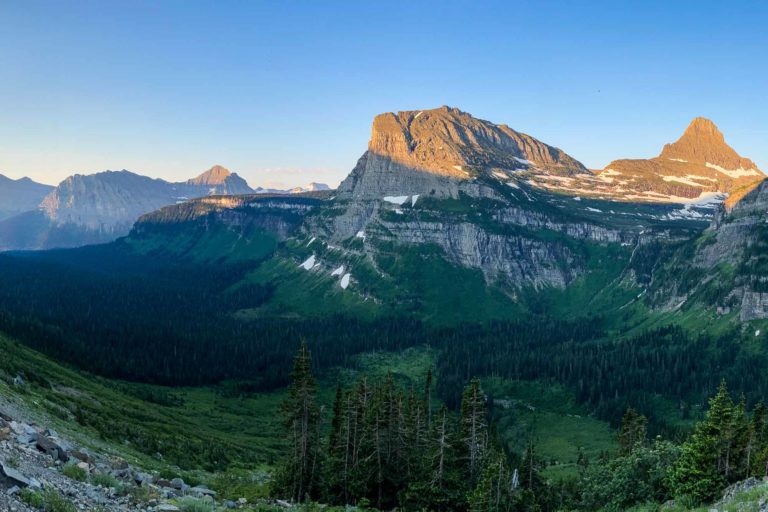
Death Valley is an incredible place to visit. One of the best experiences I have had at a National Park, but it really is a strange feeling how long you are on roads without any services coming in and out. It is an eerie feeling, but also helps one to appreciate how remote and vast the area is.
I agree. I think it’s necessary for some areas to be completely void of services or facilities to really let you experience and immerse yourself in these vast landscapes.
One of my favorites not mentioned: Mosaic Canyon: 2-4 hours, 2 miles in and 2 miles out. Fascinating canyon walls decorated by stones and pebbles cemented in by muddy flash-floods over millennia. A pleasant, moderate-difficulty hike to a 40-ish-foot-high dry waterfall point (dry because you’d never hike any canyon during weather that threatens a FLASH-FLOOD!). I’ve done this hike at least 10 times over 10 visits to Death Valley between 1992 and 2012. Just north-east of Stovepipe Wells village, it’s a great morning hike!